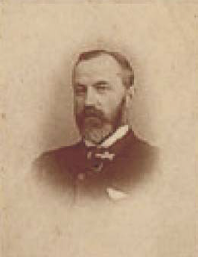
Rochford Police Station (1914 to 2012)
Article by Richard Kirton - 26th February 2012
The photograph above demonstrates how grand the red brick built Rochford Police Station looks.
It stands proud at the south end of South Street. (more photographs…)
 The building was designed by Frank Whitmore (1844-1920), an influential architect in Essex in the late nineteenth and early twentieth centuries. He was born in Wickham Market, Suffolk and according to the Royal Institute of British Architects, he died in 1920. In 1881 he was appointed surveyor to the Chelmer and Blackwater Navigation and he acted as provisional mayor of Chelmsford prior to the Borough being formed in 1888 and then as mayor in 1892-3. In Kelly's Directory of Essex of 1886, he was listed as a private resident at Maltese House, Chelmsford, Essex.
The building was designed by Frank Whitmore (1844-1920), an influential architect in Essex in the late nineteenth and early twentieth centuries. He was born in Wickham Market, Suffolk and according to the Royal Institute of British Architects, he died in 1920. In 1881 he was appointed surveyor to the Chelmer and Blackwater Navigation and he acted as provisional mayor of Chelmsford prior to the Borough being formed in 1888 and then as mayor in 1892-3. In Kelly's Directory of Essex of 1886, he was listed as a private resident at Maltese House, Chelmsford, Essex.
Frank Whitmore's earliest documented work is an ornate cast iron bridge over the River Chelmer in Howe Street, Great Waltham (1871). Early in his career he also built a new primary school at Ford End, Great Waltham (1873) and restored Mashbury Church (1873). He worked on several police stations around the county, the most accomplished of which is in New Street, Chelmsford (1903-1904). This used extensive stone dressings, including a rusticated ground floor and giant order ionic columns, with stock brick and a hexagonal corner turret in a Free Baroque style.
Rochford Police Station was another ambitious example of his work. It was built in an Edwardian Baroque Style in 1914 and along with similarly styled Police Stations at Harwich (1913-1915) and Maldon (1913) represented his last project before he retired as County Architect in 1914.
There is a leaflet produced by Chelmsford Borough Council which gives a brief profile of ‘Frank Whitmore (1844-1920) Chelmsford Architect’. This leaflet is part of a series which aims to raise awareness of the heritage of Chelmsford and can be viewed here.
I have transcribed the following article by Paul Dunt titled ‘Preserving the Scars of Rochford’s Brushes with the Luftwaffe – Brickie’s Boob Blocks Bullet Holes’. It appeared on page 9 of ‘THE LAW, NOVEMBER 1999’ (The Newspaper of the Essex Police) which makes very interesting reading. The publication is kindly made available courtesy of the Essex Police Museum.
ROCHFORD’S grand old lady may have just enjoyed a £200,000 facelift, but an eager brickie spotted patching up some unsightly holes on her rear nearly found himself wearing concrete shoes. Officers at Rochford looked on aghast as the finishing touches were added to the 77 year old building for the holes in question were the cherished scars of the station's brave brushes with the Luftwaffe. Rochford Police Station may be in a conservation area these days, but back during World War II German bombers took little notice of architectural considerations as they dodged the flak to strike the RAF base which is now Southend Airport.
“PC Bob Brett, who used to work here, remembers the bombers used to line up for their bombing run by using the roof of the police station.” said PC Rae Mill. “Then on the way back to base the rear gunner took advantage of some gunning practice by shooting up the back of the station. There are four separate bullet holes where they hit but one ricocheted around and made other indents”. “We think more probably hit the roof area. It was certainly cannon or machine gun fire and we are told they came from a Dornier bomber.” he explained “They are about the shape and size a snowball would make”.
Fortunately the repair work was spotted quickly and the poor brickie, who was completely unaware of the hole issue, began scraping out the drying mortar as fast as he could. “We had a feeling he hadn't realised their significance.” said a relieved Pc Hill. “They are quite an attraction and people are always visiting to see them.” But though the war wounds remain, a lot else has changed during the refurbishment, he says. “The architects have done us proud, it's like a home from home.”
Built at the beginning of the First World War, the police station was originally flanked on each side by a small house one for an inspector, the other for a sergeant. The houses have remained empty for more than a decade, but now they have been knocked through to the main station creating more room for the 19 sub-divisional officers stationed there. In addition the six-strong Westcliff dog section has also moved in and nine more officers are soon to move to Rochford to make up a burglary squad.
“I think it's going to be a showpiece, it appears we got the best of everything.” said Pc Hill, adding that the building had been painted in restful colours like green to help relieve stress. The station was officially opened on October 24 when the Chief Constable and the chairman of the police authority, Geoffrey Waterer were present to welcome the old lady to the nineties.
The photographs were taken in February 2012 before the closure of Rochford Police Station. As can be seen above, the bullet holes are still visible at the rear of the building and two of them have been filled in now. We have obviously become more tolerant and I have not found any indication that the building is a listed building.
The original wings which housed the Inspector and Sergeant have been knocked through since I remember from 1962. Also it looks as though there is a new single level extension at the back, adjacent to what used to be the Cell Block. There appears to be far more rooms now that the living accommodation is incorporated. These extra rooms were obviously needed to house the various changing branches of the organisation through the years. The old Cell Block has also had to be re-assigned for other purposes since it probably did not comply with the latest human rights requlations. Something that I was not aware of was the existence of a basement which housed the boiler room. It looks quite a sinister place, more so than the old cells which I remember very well.
I would like to thank various people who assisted me in my research, namely Acting District Commander Richard Baxter who enabled my access to the Police Station prior to its closure and PC Steve Thomas who kindly gave me his time and showed me around. Also, without Fred Feather’s knowledge about the Police Force, I would never have known about the bullet holes.



© 2015 - Richard Kirton - All Rights Reserved | Privacy Policy | Terms of Use | Site Map

